 W
WAbsalom, Absalom! is a novel by the American author William Faulkner, first published in 1936. Taking place before, during, and after the American Civil War, it is a story about three families of the American South, with a focus on the life of Thomas Sutpen.
 W
WThe Arabian Nights Murder, first published in 1936, is a detective story by John Dickson Carr featuring his series detective Gideon Fell. This novel is a mystery of the type known as a whodunnit.
 W
WAt the Mountains of Madness is a science fiction-horror novella by American author H. P. Lovecraft, written in February/March 1931 and rejected that year by Weird Tales editor Farnsworth Wright on the grounds of its length. It was originally serialized in the February, March, and April 1936 issues of Astounding Stories. It has been reproduced in numerous collections.
 W
WBehind the Evidence is a science fiction novel by authors Amelia Reynolds Long and William L. Crawford writing under the pseudonym Peter Reynolds. It was published in 1936 by the Visionary Publishing Company in an edition of 100 copies.
 W
WBlack Spring is a book of ten short stories by the American writer Henry Miller, published in 1936 by the Obelisk Press in Paris, France. Black Spring was Miller's second published book, following Tropic of Cancer and preceding Tropic of Capricorn. The book was written in 1932-33 while Miller was living in Clichy, a northwestern suburb of Paris. Like Tropic of Cancer, the book is dedicated to Anaïs Nin.
 W
WThe Bounty Trilogy is a book comprising three novels by Charles Nordhoff and James Norman Hall. It relates events prior to, during and subsequent to the Mutiny on the Bounty.
 W
WCaptain Salt in Oz (1936) is the thirtieth in the series of Oz novels created by L. Frank Baum and his successors, and the sixteenth written by Ruth Plumly Thompson. It was illustrated by John R. Neill.
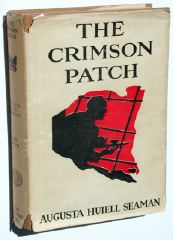 W
WThe Crimson Patch, first published in 1936, is a detective story by Phoebe Atwood Taylor which features her series detective Asey Mayo, the "Codfish Sherlock". This novel is a mystery of the type known as a whodunnit.
 W
WDrums Along the Mohawk (1936) is a novel by American author Walter D. Edmonds. The story follows the lives of fictional Gil and Lana Martin, settlers in the central Mohawk Valley of the New York frontier during the American Revolutionary War (1775–1783). Frank Bergmann wrote in 2005 that the novel, "as a best-seller and a novel perennially assigned in the state's high schools, has substantially shaped the popular view of the region's pioneer period."
 W
WFighting Angel: Portrait of a Soul (1936) is a memoir, sometimes called a "creative non-fiction novel," written by Pearl S. Buck about her father, Absalom Sydenstricker (1852–1931) as a companion to her memoir of her mother, The Exile.
 W
WGone with the Wind is a novel by American writer Margaret Mitchell, first published in 1936. The story is set in Clayton County and Atlanta, both in Georgia, during the American Civil War and Reconstruction Era. It depicts the struggles of young Scarlett O'Hara, the spoiled daughter of a well-to-do plantation owner, who must use every means at her disposal to claw her way out of poverty following Sherman's destructive "March to the Sea". This historical novel features a coming-of-age story, with the title taken from the poem “Non Sum Qualis eram Bonae Sub Regno Cynarae”, written by Ernest Dowson.
 W
WHalfway House is a novel that was written in 1936 by Ellery Queen. It is a mystery novel primarily set in New Jersey, United States.
 W
WHenner's Lydia is a 1936 children's story book written and illustrated by Marguerite de Angeli, winner of the 1950 Newbery Medal for excellence in American children's literature for another book, The Door in the Wall. Henner's Lydia is a story about a young Amish girl named Lydia Stoltzfus and her "Pop" Henner, or Henry. The story is set in Lancaster County, Pennsylvania.
 W
WThe Hurricane is a 1936 novel by Charles Nordhoff and James Norman Hall about a Pacific Ocean hurricane.
 W
WIn Dubious Battle is a novel by John Steinbeck, written in 1936. The central figure of the story is an activist attempting to organize abused laborers in order to gain fair wages and working conditions.
 W
WThe Island of the Mighty is a fantasy novel by American writer Evangeline Walton, the earliest in a series of four based on the Welsh Mabinogion. It was first published in 1936 under the publisher's title of The Virgin and the Swine. Although it received warm praise from John Cowper Powys, the book sold poorly, and as a result none of the other novels in the series reached print at the time. Later rediscovered by Ballantine Books, it was reissued under the present title as the eighteenth volume of the Ballantine Adult Fantasy series in July, 1970, with an introduction by Lin Carter and a cover by Bob Pepper. It has been reprinted a number of times since, and gathered together with Walton's other Mabinogion novels by Overlook Press as the omnibus The Mabinogion Tetralogy in 2002. The novel has also been published in translation in several European languages.
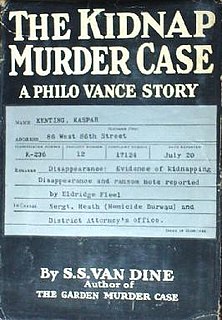 W
WThe Kidnap Murder Case is a 1936 murder mystery novel by S. S. Van Dine, the tenth of twelve books featuring fictional detective Philo Vance.
 W
WThe Lady in the Morgue (1936) is one of the novels by Jonathan Latimer featuring private detective William Crane. The lady of the title is a female corpse which is stolen from a Chicago morgue before the dead woman's identity can be established.
 W
WThe Law and the McLaughlins is a 1936 novel by Margaret Wilson first published by Doubleday, Doran & Company, Inc.. It was a sequel to her earlier Pulitzer-prize winning The Able McLaughlins.
 W
WThe Mystery of the Ivory Charm is the thirteenth volume in the Nancy Drew Mystery Stories series. It was first published in 1936 under the pseudonym Carolyn Keene. The actual author was ghostwriter Mildred Wirt Benson.
 W
WNightwood is a 1936 novel by Djuna Barnes that was first published in London by Faber and Faber. It is one of the early prominent novels to portray explicit homosexuality between women, and as such can be considered lesbian literature.
 W
WNobody's Buddy is an American children's novel written by John A. Moroso and published in 1936 by Goldsmith Publishing Co. of Chicago, Illinois.
 W
WThe Other Side of Here is an science fiction novel by American writer Murray Leinster, first published as a five-part Astounding Stories serial in 1936, under the title "The Incredible Invasion". It was first published in book form, in a "thorough revision", as one side of an Ace Double, in 1955. While no further American editions have been issued, the novel has been translated into Italian, Spanish, French and German. The novels tells the story of "an invasion from the fourth dimension", foiled by an insurrection against the invaders' home government.
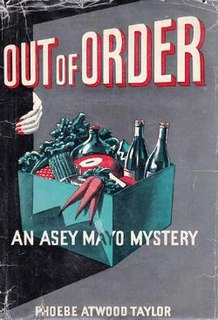 W
WOut of Order, first published in 1936, is a detective story by Phoebe Atwood Taylor which features her series detective Asey Mayo, the "Codfish Sherlock". This novel is a mystery of the type known as a whodunnit.
 W
WThe Punch and Judy Murders is a mystery novel by the American writer John Dickson Carr (1906–1977), who published it under the name of Carter Dickson. It is a whodunnit and features the series detective Sir Henry Merrivale.
 W
WRoller Skates is a book by Ruth Sawyer that won the Newbery Medal for excellence in American children's literature in 1937. It is a fictionalized account of one year of Sawyer's life.
 W
WThe Rolling Years is the first novel by the American writer Agnes Sligh Turnbull (1888–1982) and it is set in Westmoreland County, Pennsylvania, just east of Pittsburgh.
 W
WThe Rubber Band is the third Nero Wolfe detective novel by Rex Stout. Prior to its publication in 1936 by Farrar & Rinehart, Inc., the novel was serialized in six issues of The Saturday Evening Post. Appearing in one 1960 paperback edition titled To Kill Again, The Rubber Band was also collected in the omnibus volume Five of a Kind.
 W
WThe Sea of Grass is a 1936 novel by Conrad Richter. It is set in New Mexico in the late 19th century, and concerns the clash between rich ranchers, whose cattle run freely on government-owned land, a prairie "sea of grass", and the homesteaders or "nesters", who build fences and try to cultivate the soil for subsistence farming. It is an epic portrayal of the end of the cowboy era in the American Southwest on the Great Plains.
 W
WThe Shadow Out of Time is a novella by American horror fiction writer H. P. Lovecraft. Written between November 1934 and February 1935, it was first published in the June 1936 issue of Astounding Stories. The story describes time and space travel by mind transfer. The premise is that a person in a given place and time can switch bodies with someone who is elsewhere or elsewhen. Other writers have re-used this concept in later works, such as drinking tea from Red Forest leaves in the television series 12 Monkeys and long-range communication stones in the Stargate SG-1 television series. As with other Lovecraftian works, this story features otherworldy alien beings that are not simply variations on humans or other familiar terrestrial animals.
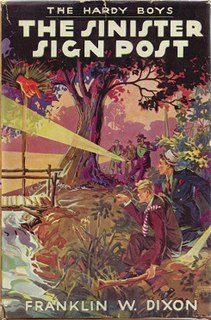 W
WThe Sinister Sign Post is Volume 15 in the original The Hardy Boys Mystery Stories published by Grosset & Dunlap.
 W
WThe Surrounded, D’Arcy McNickle's first book, was first published in 1936 by Harcourt, Brace and Company then republished in 1964 and again in 1978 by the University of New Mexico Press. McNickle was a Cree Métis author enrolled as Salish-Kootenai on the Flathead Indian Reservation.
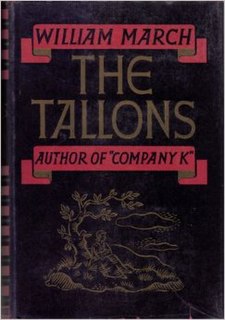 W
WThe Tallons is the second novel in Alabama author William March’s “Pearl County” collection of novels and short fiction. It is an example of the Southern Gothic genre. Like its predecessor, Come in at the Door and sequel, The Looking-Glass, The Tallons is set in the mythical towns of Reedyville and Baycity, the latter offering a fictionalized vision of Mobile, Alabama. The book was first published in 1936 by Random House in New York and republished by the University of Alabama Press in 2015.
 W
WTarzan's Quest is a novel by American writer Edgar Rice Burroughs, the nineteenth in his series of twenty-four books about the title character Tarzan. Originally serialized in six parts, as Tarzan and the Immortal Men, in The Blue Book Magazine, from October 1935 to March 1936; the first collected edition was published as the 1936 novel Tarzan’s Quest by Burroughs’ own publishing company.
 W
WThe U.S.A. trilogy is a series of three novels by American writer John Dos Passos, comprising the novels The 42nd Parallel (1930), 1919 (1932) and The Big Money (1936). The books were first published together in a volume titled U.S.A. by Modern Library in 1937.
 W
WWe the Living is the debut novel of the Russian American novelist Ayn Rand. It is a story of life in post-revolutionary Russia and was Rand's first statement against communism. Rand observes in the foreword that We the Living was the closest she would ever come to writing an autobiography. Rand finished writing the novel in 1934, but it was rejected by several publishers before being released by Macmillan Publishing in 1936. It has since sold more than three million copies.